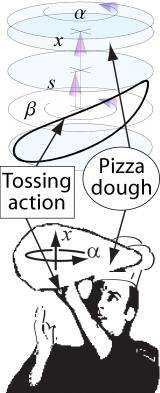April 9, 2009 feature
The Physics of Pizza Tossing

(PhysOrg.com) -- As dough flies through the air, transforming from a ball into a disk in the chef’s experienced hands, pizza tossing can definitely be thought of as an art. But, as a recent study shows, pizza tossing is also a science.
Researchers at the MicroNanophysics Research Laboratory at Monash University in Melbourne, Victoria, Australia, have developed a model of pizza tossing based on observations of professional chefs tossing dough. They came up with calculations that describe the dough’s trajectory, allowing them to identify the optimal tossing motions in terms of rotational speed, stability, and energy efficiency. Besides being an interesting description, the results could also help researchers in designing optimal standing wave ultrasonic motors (SWUMs), which operate on similar principles as pizza tossing.
“At first it started from a conversation I had with a colleague, Dr. Heidi Forde from medicine here at Monash University,” James Friend, coauthor of the study, told PhysOrg.com. “She couldn't understand how our little motors worked. So I had the flash of insight that, well, they work like a chef tossing pizza dough. The dough spins just like the rotor spins because the chef tosses the rotor just like the motor does; the differences between the two are just really in the details. Turns out no one had apparently thought about how to really toss pizza, either, so that became a bigger part of what we looked at with this, and when we found that experts tossed pizza exactly as the theory said they should for optimum results, we were thrilled.”
In their study, the researchers predicted that the tossing motion used by professional chefs and performers provides certain advantages in terms of effort, speed, and ease of handling. They explain that a tossed disk experiences four distinct phases: parabolic flight, impact (upon landing in the chef’s hands), sticking contact (as the chef’s hands grip the dough), and sliding contact (as the chef prepares to toss the dough). By determining the correct descriptions and durations of these four phases, the scientists could solve the pizza’s motion.
The researchers investigated two types of dough tossing: single tossing and multiple tossing. In single tossing (when tossing the dough from rest), they found that the optimal motion is a helical, or spiral-like, trajectory. As the scientists explain, when the dough is at rest, torque (twist) must be transferred to the dough via sliding or static friction. When the dough is in the air, its airborne rotational speed matches the rotational speed the chef gives it at the moment of separation. For this reason, single tosses follow a spiral-like trajectory.
Advanced dough tossers can perform multiple tosses (tossing the dough repeatedly before it rests in the chef’s hands). In multiple tossing, the scientists found that the optimal motion is a semi-elliptical trajectory, in which the disk flies through the air at an angle rather than flying perfectly flat. Multiple tossing is more complex, as it risks entering chaotic and chattering regimes, emphasizing the disk’s sensitive dependence on initial conditions. Generally, dough tossers use the helical motion for the first toss, and change to a semi-elliptical motion for subsequent tosses.
As the scientists explain, multiple tossing shares similarities with standing wave ultrasonic motors, since both convert reciprocal input into continuous rotational motion using the same mechanism. The electric motors operate by using friction from the ultrasonic vibration of a stator to spin a rotor. Engineers who design these motors generally give the stator an elliptical motion, in accordance with the findings from the researchers’ pizza tossing analysis. However, the researchers found that the reason for the preferred elliptical motion is different than motor engineers have assumed. This insight and further investigation might help designers improve the operation of the motors in new ways.
“Our work is focused on developing effective microactuation technology - devices and physical understanding of phenomena at the micro- to nano-scale that can be used to deliver controlled and powerful motion for microrobotics, mainly for surgery,” Friend said. “This study's greatest achievement is that it answers many of the more perplexing questions in how ultrasonic piezoelectric motors actually work: why does the choice of materials in them not work as expected, why do they make such unbearably loud noises when improperly designed, why do the rotors not spin as expected, and so on.”
More information: Liu, K.-C.; Friend, J.; and Yeo, L. “The behavior of bouncing disks and pizza tossing.” Europhysics Letters, 85 (2009) 60002, doi: 10.1209/0295-5075/85/60002.
Copyright 2009 PhysOrg.com.
All rights reserved. This material may not be published, broadcast, rewritten or redistributed in whole or part without the express written permission of PhysOrg.com.




















